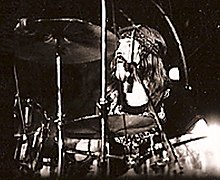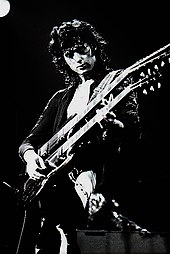Musical style[edit]
Led Zeppelin's music was rooted in the blues.[12] The influence of American blues artists such as Muddy Waters and Skip James was particularly apparent on their first two albums, as was the distinct country blues style ofHowlin' Wolf.[121] Tracks were structured around the twelve-bar blues on every studio album except for one, and the blues directly and indirectly influenced other songs both musically and lyrically.[122] The band were also strongly influenced by the music of the British, Celtic, and American folk revivals.[12] Scottish folk guitarist Bert Jansch helped inspire Page, and from him he adapted open tunings and aggressive strokes into his playing.[26] The band also drew on a wide variety of genres, including world music,[12] and elements of early rock and roll, jazz, country, funk, soul, and reggae, particularly on Houses of the Holy and the albums that followed.[121]
The material on the first two albums was largely constructed out of extended jams of blues standards[12] and folk songs.[123][124] This method led to the mixing of musical and lyrical elements of different songs and versions, as well as improvised passages, to create new material, but would lead to later accusations of plagiarism and legal disputes over copyright.[123] Usually the music was developed first, sometimes with improvised lyrics that might then be rewritten for the final version of the song.[124] From the visit to Bron-Yr-Aur in 1970, the songwriting partnership between Page and Plant became predominant, with Page supplying the music, largely via his acoustic guitar, and Plant emerging as the band's chief lyricist. Jones and Bonham then added to the material, in rehearsal or in the studio, as a song was developed.[125] In the later stages of the band's career, Page took a back seat in composition and Jones became increasingly important in producing music, often composed on the keyboard. Plant would then add lyrics before Page and Bonham developed their parts.[126][127]
Early lyrics drew on the band's blues and folk roots, often mixing lyrical fragments from different songs.[128] Many of the band's songs dealt with themes of romance, unrequited love and sexual conquest, which were common in rock, pop and blues music.[129] Some of their lyrics, especially those derived from the blues, have been interpreted as misogynistic.[129] Particularly on Led Zeppelin III, they incorporated elements of mythology and mysticism into their music,[12] which largely grew out of Plant's interest in legends and history.[130] These elements were often taken to reflect Page's interest in the occult, which resulted in accusations that the recordings contained subliminal satanic messages, some of which were said to be contained in backmasking; these claims were generally dismissed by the band and music critics.[131] Susan Fast argues that as Plant emerged as the band's main lyricist, the songs more obviously reflected his alignment with the West Coast counterculture of the 1960s.[132] In the later part of the band's career Plant's lyrics became more autobiographical, and less optimistic, drawing on his own experiences and circumstances.[133]
According to musicologist Robert Walser, "Led Zeppelin's sound was marked by speed and power, unusual rhythmic patterns, contrasting terraced dynamics, singer Robert Plant's wailing vocals, and guitarist Jimmy Page's heavily distorted crunch".[134] These elements mean that they are often cited as one of the progenitors of hard rock[135] and heavy metal[134][4] and they have been described as the "definitive heavy metal band",[12] although the band members have often eschewed the label.[136] Part of this reputation depends on the band's use of distorted guitar riffs on songs like "Whole Lotta Love" and "The Wanton Song".[10][137] Often riffs were not doubled by guitar, bass and drums exactly, but instead there were melodic or rhythmic variations;[138] as in "Black Dog", where three different time signatures are used.[139] Page's guitar playing incorporated elements of the blues scale with those of eastern music.[140]Plant's use of high-pitched shrieks has been compared to Janis Joplin's vocal technique.[10][141] Bonham's drumming was noted for its power, his rapid rolls and his fast beats on a single bass drum.[142] Jones' basslines have been described as melodic and his keyboard playing added a classical touch to the band's sound.[143][10]
Page stated that he wanted Led Zeppelin to produce music that had "light and shade". This began to be more clearly realised beginning with Led Zeppelin III, which made greater use of acoustic instruments.[12] This approach has been seen as exemplified in the fourth album, particularly on "Stairway to Heaven", which begins with acoustic guitar and recorder and ends with drums and heavy electric sounds.[139][144] Towards the end of their recording career, they moved to a more mellow and progressive sound, dominated by Jones' keyboard motifs.[145] They also increasingly made use of various layering and production techniques, including multi-tracking and overdubbed guitar parts.[121]Their emphasis on the sense of dynamics and ensemble arrangement[121] has been seen as producing an individualistic style that transcends any single music genre.[146][147] Ian Peddie argues that they were "... loud, powerful and often heavy, but their music was also humorous, self-reflective and extremely subtle".[148]


No comments:
Post a Comment